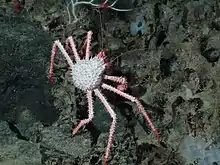Neolithodes
Neolithodes is a genus of king crabs, in the family Lithodidae.[2] They are found in all major oceans, both in high and low latitudes. Although there are records from water as shallow as 124 m (407 ft) in cold regions, most records are much deeper, typically 700–2,000 m (2,300–6,600 ft), with the deepest confirmed at 5,238 m (17,185 ft).[3][4][5][6] They are fairly large to large crabs that typically are reddish in color and spiny, although the size of these spines varies depending on species (from long in species like N. grimaldii to very short in species like N. flindersi, and tending to be more pronounced in small than in large individuals).[5][7]
| Neolithodes | |
|---|---|
 | |
| Neolithodes crab at the Davidson Seamount off California | |
| Scientific classification | |
| Kingdom: | Animalia |
| Phylum: | Arthropoda |
| Subphylum: | Crustacea |
| Class: | Malacostraca |
| Order: | Decapoda |
| Family: | Lithodidae |
| Genus: | Neolithodes Milne-Edwards & Bouvier, 1894 |
| Species | |
| |
Various sessile organisms such as barnacles are sometimes attached to their carapace and legs,[4][8] and small commensal amphipods may live in their carapace.[9] They are occasionally the victims of parasitic snailfish of the genus Careproctus, which lay their egg mass in the gill chamber of the crab, forming a mobile "home" until they hatch.[5] Conversely, some juvenile Neolithodes have a commensal relationship with Scotoplanes sea cucumbers. To protect itself from large predators, the young crab hides under the sea cucumber.[10]
The word Neolithodes derives from the Greek neo, meaning new, and Lithodes, a closely related genus of king crab. The name of the latter genus originates from the Latin lithodes, meaning stone like.[11]
Species
The following species are in this genus:[2]
- Neolithodes agassizii (Smith, 1882)
- Neolithodes asperrimus (Barnard, 1947)
- Neolithodes brodiei (Dawson & Yaldwyn, 1970)
- Neolithodes bronwynae (Ahyong, 2010)
- Neolithodes capensis (Stebbing, 1905)
- Neolithodes diomedeae (Benedict, 1894)
- Neolithodes duhameli (Macpherson, 2004)
- Neolithodes flindersi (Ahyong, 2010)
- Neolithodes grimaldii (Milne-Edwards & Bouvier, 1894)
- Neolithodes nipponensis (Sakai 1971)
- Neolithodes vinogradovi (Macpherson, 1988)
- Neolithodes yaldwyni (Ahyong & Dawson, 2006)
References
- Türkay, Michael. "Neolithodes Milne-Edwards & Bouvier, 1894". World Register of Marine Species. Retrieved 17 November 2018.
- "Neolithodes A. Milne-Edwards & Bouvier 1894 | Names". Encyclopedia of Life. Retrieved 17 November 2018.
- Stevens, Bradley G., ed. (2014). King Crabs of the World: Biology and Fisheries Management. CRC Press. doi:10.1201/b16664. ISBN 978-1-4398-5541-6. LCCN 2013036692.
- Quigley, Declan T. G.; Flannery, Kevin (April 1997). "Neolithodes grimaldii Milne Edwards & Bouvier 1894 (Lithodes goodei Benedict 1895) (Crustacea: Decapoda: Anomura) in Irish offshore waters". Irish Naturalists' Journal. 25 (10): 373–374. JSTOR 25536085. Retrieved 14 May 2020 – via ResearchGate.
- Ahyong, Shane T. (18 February 2010). "Neolithodes flindersi, a new species of king crab from southeastern Australia (Crustacea: Decapoda: Lithodidae)". Zootaxa. 2362: 55–62. doi:10.5281/zenodo.193654. Retrieved 14 May 2020 – via ResearchGate.
- Macpherson, Enrique (2001). "New species and new records of lithodid crabs (Crustacea, Decapoda) from the southwestern and central Pacific Ocean" (PDF). Zoosystema. 23 (4): 797–805. Archived (PDF) from the original on 13 August 2017. Retrieved 14 May 2020 – via the Natural History Museum of Los Angeles County.
- "Neolithodes grimaldii" (PDF). Newfoundland and Labrador Department of Fisheries and Aquaculture. Archived from the original (PDF) on 24 September 2015. Retrieved 26 May 2019.
- Williams, Ruth; Moyse, John (May 1988). "Occurrence, Distribution, and Orientation of Poecilasma kaempferi Darwin (Cirripedia: Pedunculata) Epizoic on Neolithodes grimaldi Milne-edwards and Bouvier (Decapoda: Anomura) in the Northeast Atlantic". Journal of Crustacean Biology. 8 (2): 177–186. doi:10.2307/1548310. JSTOR 1548310.
- Soto, Luis A.; Corona, Adriana (31 December 2007). "Gammaropsis (Podoceropsis) grasslei (Amphipoda: Photidae) a new species of commensal amphipod of the deep-water lithodid Neolithodes diomedeae from the Guaymas Basin, Gulf of California". Zootaxa. 1406: 33–39. doi:10.5281/zenodo.175510.
- Barry, James P.; Taylor, Josi R.; Kuhnz, Linda A.; DeVogelaere, Andrew P. (15 October 2016). "Symbiosis between the holothurian Scotoplanes sp. A and the lithodid crab Neolithodes diomedeae on a featureless bathyal sediment plain". Marine Ecology. 38 (2): e12396. doi:10.1111/maec.12396. eISSN 1439-0485.
- Emmerson, W.D. (July 2016). A Guide to, and Checklist for, the Decapoda of Namibia, South Africa and Mozambique. Volume 2. Cambridge Scholars Publishing. pp. 90–93. ISBN 978-1-4438-9097-7.
External links
 Media related to Neolithodes at Wikimedia Commons
Media related to Neolithodes at Wikimedia Commons Data related to Neolithodes at Wikispecies
Data related to Neolithodes at Wikispecies